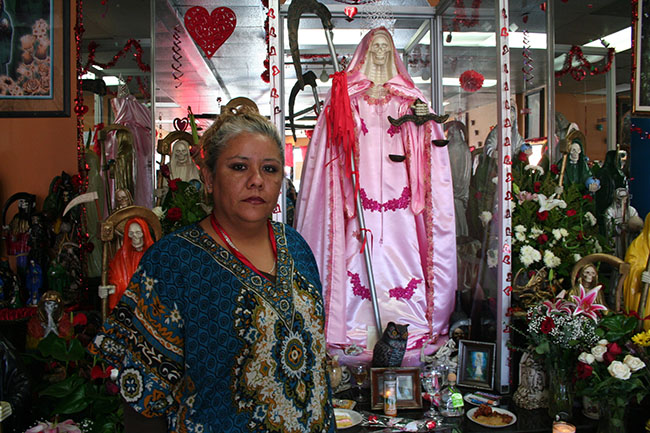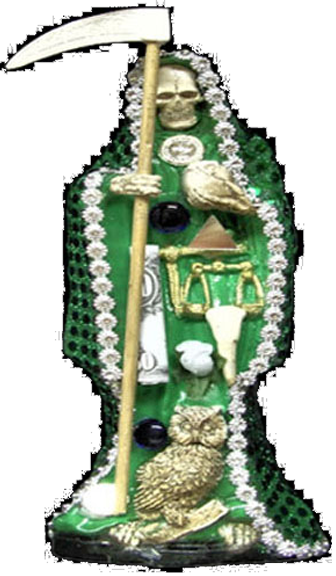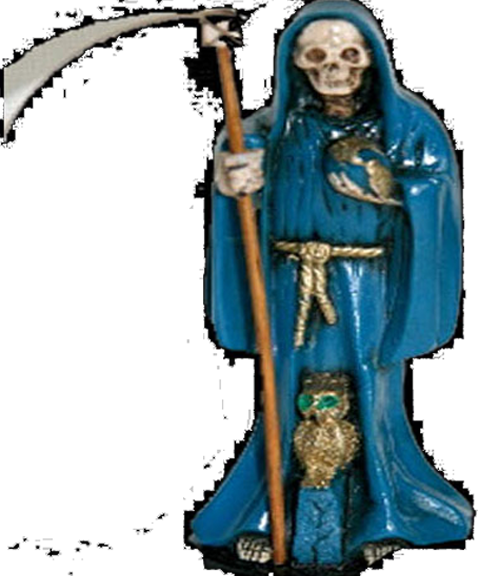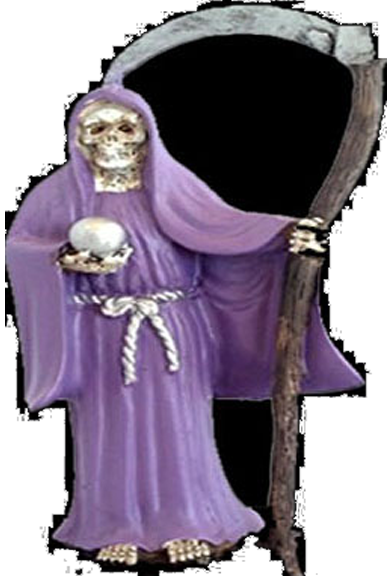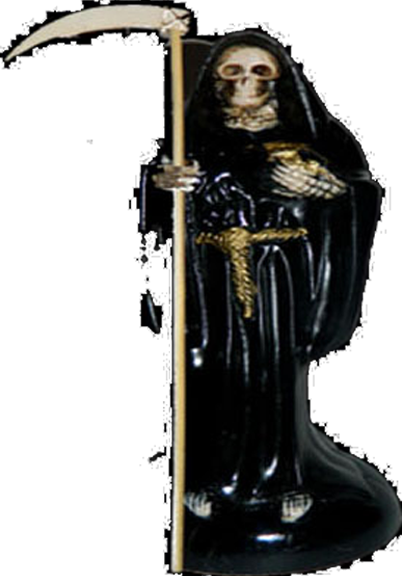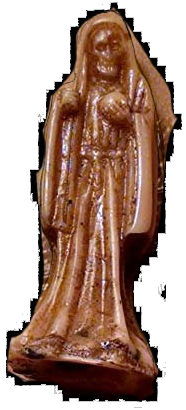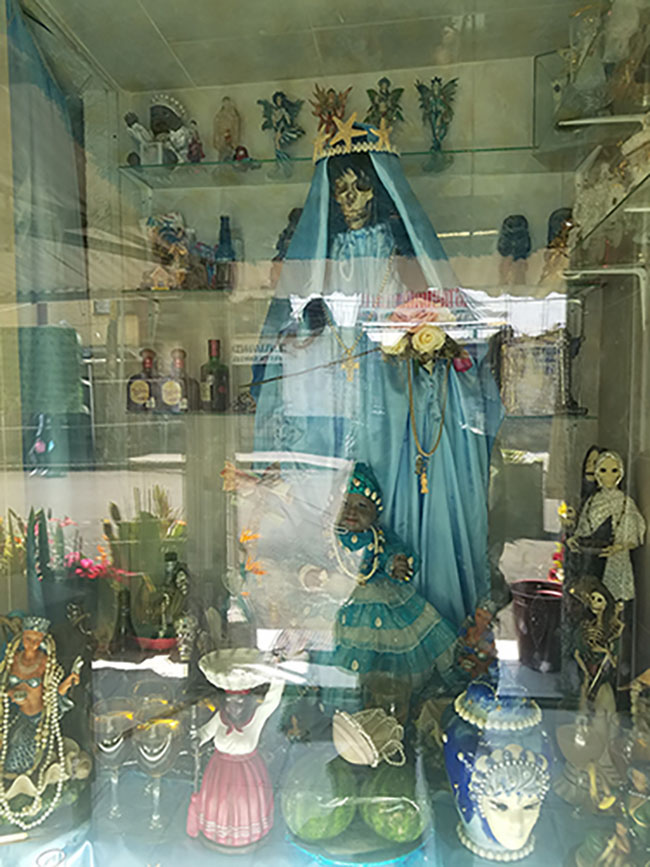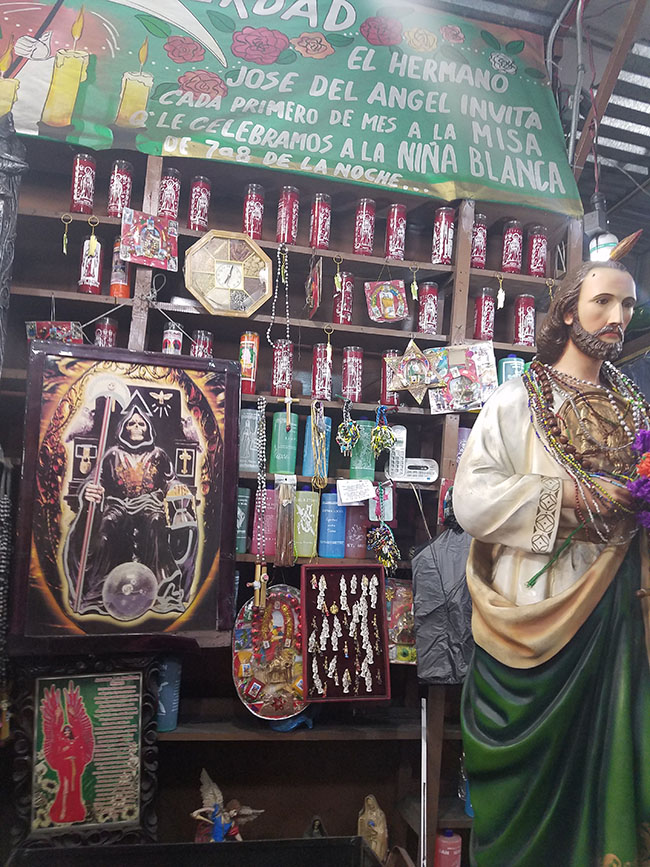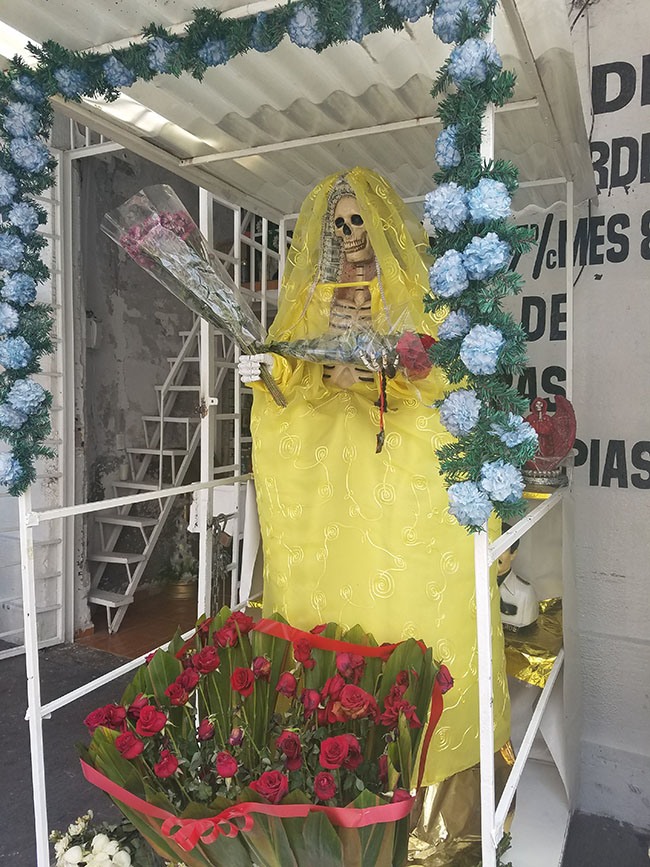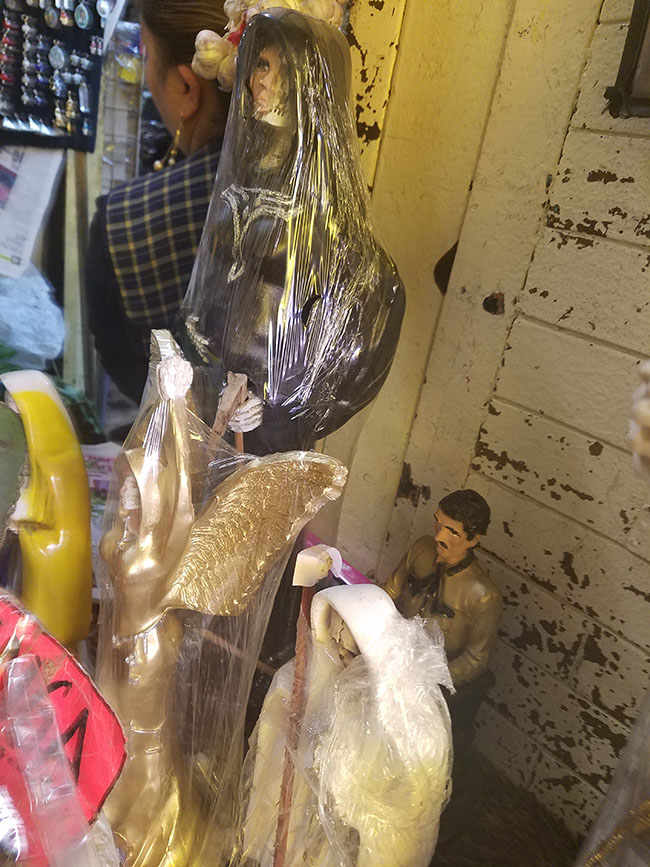Santa Muerte Across the Americas
The death saint gives new meaning to life for followers on both sides of the border.
By Melanie Gonzalez
Holy Death in Los Angeles
The commercial district on Florence Avenue in Huntington Park looks like most others found in the working-class towns of southeast Los Angeles County: a mix of panaderías selling fresh-baked pan dulce and coffee, mini-markets, pawn shops, party planning and quinceañera photography businesses, and botanicas selling home remedies and other esoteric items to the Latino-majority population.
A short walk away sits a storefront that traffics in a different sort of currency: miracles. At the Templo Mayor de la Santa Muerte, patrons gather daily to pray to the folk saint, whose name translates as “Holy Death.”
Temple leader Profesora Lucila, or Profe Lucila la Madrina, as regulars affectionately call her, mops the tile floors, which are so clean they reflect the images of the flowers that line the feet of the myriad Santa Muerte statues in the temple. Her black cat, Rigo, lies down on a wooden table near the entrance, where Lucila receives guests seeking Santa Muerte’s assistance in matters of love, guidance on legal affairs and protection from harm.
"More people believe in Santa Muerte because we [the followers] are sincere," Lucila says. "We do not judge if you are a cholo or a lawyer. Everyone is welcome, and we do not discriminate."
Santa Muerte is condemned by politicians and priests yet is Mexico's second-most-revered religious figure, after the Virgin of Guadalupe. Her reach stretches into the Spanish-speaking communities of Los Angeles, where immigrants have brought her from Mexico and a new generation of American-born followers has arisen.
Devotees refer to Santa Muerte affectionately as La Niña Blanca (the white girl), La Flakita (the little skinny girl), La Huesuda (the bony lady) or La Niña Bonita (the pretty girl). With the second-largest population of Mexicans outside of Mexico City, Los Angeles is the hotbed of Santa Muerte devotion, says Andrew Chesnut, professor of religious studies at Virginia Commonwealth University and author of "Devoted to Death: The Skeleton Saint" (2012). Santa Muerte has also reached cities with large Latino populations such as Miami, New York City and Houston.
In his research, Chesnut found that Santa Muerte has origins in La Parca, the Spanish grim reaper who was brought to the Americas to evangelize indigenous people, and Mexican followers believe her to have origins in Mictecacihuatl, the Aztec goddess of death.
“The Spanish didn’t know the indigenous people had their own death deities. It’s likely the case that over time they transformed the Spanish La Parca to the Santa Muerte. For the Europeans the grim reaper was never a holy figure; it was a mere personification of death. It wasn’t a supernatural figure who people ask miracles for,” Chesnut says in an interview.
In his book, Chesnut writes that the first reference to Santa Muerte in Spanish colonial records appeared in the late 1700s.
Mexico isn’t the only culture with a personification of death. Chesnut cites San La Muerte, who has a following in Argentina and Paraguay, and Rey Pascual, who originates from Guatemala.
“San La Muerte is much less commercialized, much more austere, and doesn’t have the
big product line,” he says.
Santa Muerte was mostly underground until making headlines in 2009, when then-President of Mexico Felipe Calderon ordered the military to bulldoze about 40 shrines that were along the U.S.-Mexico border.
The first legal Santa Muerte church in Mexico City opened in 2003, but it was closed by the government in 2005 under pressure from the Roman Catholic Church, Chesnut says. (He says that the Santa Muerte temple’s leader, David Romo, is now serving 60 years in prison for being part of a kidnapping ring.)
Santa Muerte Colors
Santa Muerte is a multipurpose saint, so her statues and candles come in various colors. Devotees may purchase a statue for a specific petition, or a light a candle at their altar in one of these colors. Hover over each statue to learn about what each color represents.
Images by Melanie Gonzalez
Source: "Devoted to Death: Santa Muerte The Skeleton Saint," by Andrew Chesnut (2012).
Santa Muerte became known in the media as the symbol of narcocultura, or the drug culture. Chesnut writes in his book that Santa Muerte has followers on both sides of the drug war, from police and army officers to cartel members. His book details cases in which narcos were caught with Santa Muerte paraphernalia.
Lucila credits Santa Muerte with helping her survive four heart attacks and lung cancer. She calls the folk saint an intermediary between God and the people, because according to Lucila, it is death that comes to collect people’s souls when God decides it is time for somebody to die.
“Here I teach everybody that they give a hug and a kiss to their loved ones before leaving our house, because we never know if that is going to be the last kiss or hug that we give to our loved ones,” Lucila says.
She’s been leading the temple for the past five years. Lucila says that her position in the cult comes from a don, or gift, that Santa Muerte spiritual leaders have since birth, but that she is only a guide to help members of the temple.
“I always say, ‘First is God, then La Santa. You do not have to believe in me.’ I am just a guide who can help them raise their energy,” Lucila says. Because of the followers she comes into contact with daily, she wears a silver link chain with a Santa Muerte charm to protect her from negative energy.
The trust and confidence devotees have for Profesora Lucila are an example of women’s roles as leaders and importance in Santa Muerte worship.
“There’s an angle of women’s empowerment. The top leader of [Santa Muerte in] Mexico is a woman. That doesn’t happen in the Catholic Church. Besides the obvious fact that she’s a female saint, you have all this room for female leadership. That’s an important aspect of her popularity,” says Chesnut. “The image of Virgin Mary in Mexico and throughout the world has been used to reinforce patriarchy, because you’re either a puta or you’re a madre [a whore or a mother], and obviously she’s[the Virgin Mary] the exemplary model of motherhood.”
Brisa Argelia and her husband, Guillermo Gutierrez, Huntington Park residents in their 30s, are regulars at Profesora Lucila’s Sunday rosarios, or rosary services. Argelia, a housewife, regularly visits the shrine during the week and helps with cleaning. Gutierrez accompanies her whenever he has time off from his day job as a manager for an automotive company. With her blue-and-pink hair, and his all-black clothing and tattoos, they look like the type of people who would be drawn to a robed skeleton folk saint.
On the side, Gutierrez has been tattooing for four years. He says he has done about 15 Santa Muerte tattoos, including a black-and-white portrait of her wearing a white lace veil for Profesora Lucila. (She says she doesn’t allow it to be photographed because it came out of a secret promise she made to the saint.)
“I promised the Santa that whatever design the Profe wanted, that I wouldn’t charge her so much,” Gutierrez says of the tattoo, which Lucila has on her forearm. “For other people the same design would be about $400.”
Devotees get tattoos with her image as promises for miracles she has worked for them. Gutierrez has three Santa Muerte tattoos: one on each arm and one that takes up his whole chest.
He says he first learned of Santa Muerte 12 years ago through a friend.
“I had always been atheist, but at first I was afraid of her because I didn’t really know much about her,” he says. “But through this friend I began learning more little by little.”
Gutierrez became a true believer, he says, after she granted him a big favor. He had about five traffic violations including driving without a seat belt and speeding. A warrant was out for his arrest. He didn’t have the money to pay those five tickets, and he was getting nervous.
“It was either pay or stay in jail,” he says. Gutierrez prayed to Santa Muerte, asking her to intervene on his behalf. When he appeared in front of a judge, he was given six extra months to pay off his tickets.
“It was incredible. I never heard of anyone getting a six-month extension to pay for all these tickets,” he says.
Since then, Gutierrez has maintained an altar in his home that includes a red, white, green and black Santa Muerte statue, with candy, bread, water and flowers as offerings. He keeps a white candle lit and replaces it when it burns out.
Gutierrez and Argelia met about eight years ago. She knew about his devotion to Santa Muerte, but he didn’t push his beliefs on her. Argelia says she felt a mix of respect and fear of the image.
When Argelia was pregnant with their first child together, her physician told her there was a 70 percent chance that she would lose the baby because of liver disease she had contracted during the pregnancy. Gutierrez suggested that they pray together at the altar. Argelia has a daughter, Roshni, from a previous relationship.
“I know God exists, but I don’t know if you exist. If you exist show me your power,” Argelia remembers saying to the little statue at their home altar. Argelia returned to the doctor a week later. “The doctor told me, ‘I don’t know what’s going on, but your pregnancy is improving even though your liver is the same.’ The tears came to my eyes, and that’s when my devotion grew.”
As a gesture of thanks, Gutierrez designed a Santa Muerte tattoo for Argelia. The baby, Jared, was born in 2013. It is a rosary drawn in black ink, and in place of Jesus on the cross it depicts Santa Muerte dangling from black rosary beads in a robe.
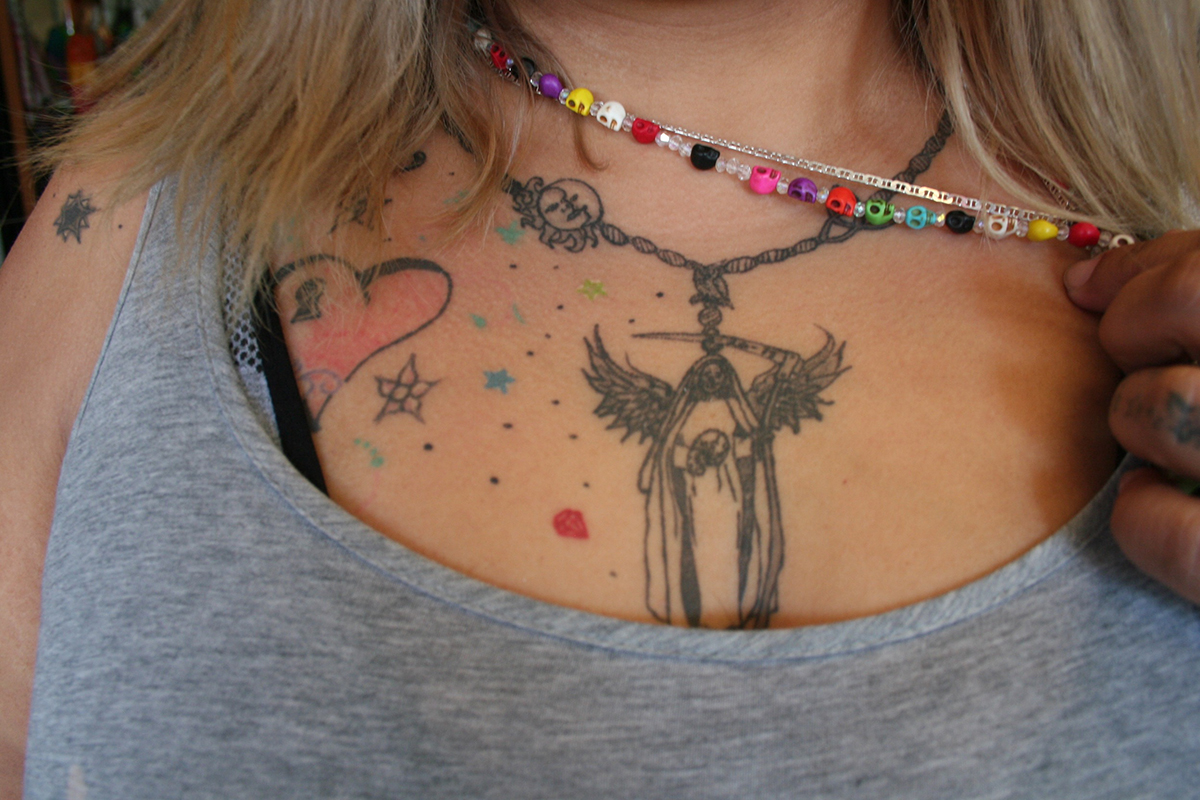
Argelia's rosary tattoo, which Guitierrez designed after the birth of their child Jared in 2013. Photo: Melanie Gonzalez

Gutierrez's first Santa Muerte tattoo on his right arm. Many Santa Muerte devotees have tattoos as a symbol of appreciation for her miracles. Photo: Melanie Gonzalez

Gutierrez has this Santa Muerte tattoo on his left arm. This tattoo was done by a friend, but Gutierrez has been tattooing for four years. Photo: Melanie Gonzalez

Gutierrez and Argelia often help Profesora Lucila with temple upkeep, aside from attending the Sunday rosarios. Photo: Melanie Gonzalez
Before embracing Santa Muerte, Argelia was raised by her mother as a Jehovah’s Witness. As she grew older she became more interested in Catholicism but wasn’t a fan of how it is traditionally practiced. Nowadays, Argelia has a strained relationship with her mother, who she says respects her beliefs but has no interest in learning about Santa Muerte. Argelia also has an uncle back in Mexico who has been a Santa Muerte devotee for at least 50 years.
Argelia says that she gives her children the freedom to choose their own religion. Her eldest child, Roshni, 11, wears a silver Santa Muerte on a chain for protection and likes to sit in front of the home altar to talk to the folk saint when she’s had a bad day at school.
“My way of thinking is that you can have your own beliefs. If it is something that helps you and you are receiving all the answers to your questions, then that is something that person should believe,” Argelia says.
She says she found Profesora Lucila and the Templo Mayor de la Santa Muerte three years ago while driving around Huntington Park. Though she and her husband prayed and maintained an altar at home, Argelia felt the need to find an actual place of worship to feel that Santa Muerte really existed. Other followers she knew told her about the Santuario Hogar de la Santa Muerte in Los Angeles’ MacArthur Park neighborhood, but she always got lost trying to find it. Upon walking in and seeing the life-size figure of Santa Muerte at Lucila’s temple, she was overtaken with emotion.
“I cried and I said, ‘Finally, I am in front of you,’” she recalls.
Inside the Templo Mayor de La Santa Muerte
Click on the different hotspots to have an up-close look at Profesora Lucila's place of worship, and listen to prayers commonly recited at rosarios. Photos: Melanie Gonzalez
Both Argelia and Gutierrez say they like the friendly atmosphere at the temple. The regulars know each other by name, and greet each other with a hug and a smile. Before the rosario begins, Lucila cleanses the temple by burning copal, a resin that comes from trees native to Mexico. (It has been used in ancient indigenous ceremonies and is often burned during Aztec dance performances and during Día de los Muertos observances.) The thick smoke blankets the room, and she begins to read from La Biblia de la Santa Muerte, or the Santa Muerte Bible, a book that contains prayers, rituals and the rosario. The devotees make the sign of the cross, and the rosary begins with an “Our Father.”
While leading the prayers, Profesora Lucila walks around the room, sometimes laying her hands on the back of one of the followers
“Everyone brings a different energy to the templo,” she says. “I do this to protect the others from any negative energy they might bring into the room. If I were doing the rosario for just one person, I would stand right next to them the whole time.”
The rosario is similar to praying a Catholic rosary, but along with reciting the “Our Father” and “Hail Mary,” the rosario to Santa Muerte includes prayers about her different healing powers: protection, love, prosperity, health, wisdom and purity.
In the middle of the rosario, Lucila stops and has the worshippers choose a Santa Muerte statue to pray in front of for an issue that concerns them at the moment. While she is leading the followers in prayer, she will occasionally stop and kiss one of the statues on the head.
Lucila takes note when one of the devotees begins to mess up the prayer.
“If you are making mistakes, your mind is in another place. How do you expect the Santa to help you if your mind is not with her?” she chides, speaking to all of those in the room. “If your mind is not with her, then neither is your heart.”
North of Huntington Park lies East Los Angeles, a mostly Mexican-American neighborhood. On Whittier Boulevard sits a storefront that is only a fraction of the size of Lucila’s temple, the Basilica Santa Muerte. Devotee Angel Suarez is originally from Cuernavaca, Mexico, and comes from a family of believers. Once afraid of death, he recalls an experience that happened to him on the streets of Los Angeles. One evening while walking home, Suarez says, a gang member with tattoos on his face pulled a gun and attempted to rob him.
“Hijo de la chingada,” Suarez recalls saying to his assailant. “I’m not going to give you anything, so you better shoot me or else I’m going to kick your ass.” Suarez claims that the man then shook his hand and left because nobody had ever stood up to him before.
“I said I was protected by my Santa Muerte, and he told me he kept an altar at home, too,” Suarez says.
Further west, in MacArthur Park, a neighborhood known for its mostly Central American immigrant families, lies the Santuario Hogar de la Santa Muerte. The temple is led by a woman whom followers call Profesora Cielo, who declined to be interviewed. Sunday rosarios are led by a man who calls himself Profesor Lucio. The two leaders also host raffles for prizes ranging from microwaves to baskets filled with small Santa Muerte statues and candles.
Lucio, a gardener by day, came to the United States from Oaxaca, Mexico, when he was 15 years old. He says he comes from a family that practices witchcraft. In addition to Spanish, he speaks Zapotec and Latin. As a boy, he spent time at a seminary, but he left the Catholic Church when he came to the United States because he found it to be hypocritical.
“The adoration of death comes many years before Christ,” he says. “The Egyptians and other cultures around the world all worshipped death, but the Spanish didn’t want us to continue with our traditions.”
Santa Muerte’s popularity is also evident in Los Angeles’ botanicas. Juan Perez, owner of the Botanica de Los Angeles in MacArthur Park, had a special altar to San Simon, a Guatemalan folk saint.
“This is a Central American community, so I still get people asking for San Simon, but most of my sales comes from Santa Muerte,” he says.
In his botanica, Santa Muerte shares space with red candles (decorated with a yellow hummingbird to attract love), statues of San Lazaro and the Virgin Mary, and packets of dried herbs. “I added Santa Muerte to stay in business,” Perez says.
Santa Muerte and Her LGBTQ Followers
Furthering the belief that she is a saint who is accepting of people from different walks of life, Santa Muerte holds a special place for followers in the LGBTQ community. Arely Vazquez is a transgender woman who is a cosmetologist by day and now a leader of devotees in Queens, New York. She organizes a celebration every August in honor of Santa Muerte, whom Vazquez refers to as mi Flakita, “my skinny little lady.”
“We know that Mexico is a country that is very machista” — male chauvinist — “and traditional,” Vazquez says. “I knew if I stayed I wasn’t going to have the life I wanted with the identity I wanted to have. I knew since I was very little that I was different from everyone else.”
Vazquez became a follower after a friend she met in New York gave her a candle and a small white Santa Muerte statue 12 years ago. Since then, Vazquez opens up her home altar for Saturday prayers the first Saturday of every month.
“About 11 years ago I had surgery on my pancreas,” Vazquez says. “I thought I was going to die. I promised my Santa Muerte that if she would help me survive, I would organize an event in her honor so that more people would come to know her.”
After regaining her health, she took on the task of preparing food for the party (which included pozole, tamales and mole) and sewed a green gown for Santa Muerte. The first fiesta, in an event space that lacked a finished floor and walls, was attended by at least 80 people, a turnout that Vazquez didn’t expect. These days, Vazquez has had to move to a bigger event space, as turnout numbers in the hundreds. She commissions a new dress for Santa Muerte every year, using the same person who designed her wedding dress.
“The goal is always to make her look like the queen that she is,” Vazquez says. “I always make each fiesta simple, beautiful and elegant, like a wedding or a quinceañera because I don’t want people to think she is evil."
Vazquez has a dress specially made for herself on the fiesta days as well. Last year she invited Enriqueta Vargas, of the Templo Santa Muerte Internacional in Tultitlán, a suburb of Mexico City, who is one of the most revered leaders of the cult.
In addition to her fiestas and Saturday prayers, Vazquez opens her shrine to devotees who would like to leave offerings, candles and petitions. She says some followers feel they have to keep their devotion hidden because a Santa Muerte altar might not be accepted by their families at home.
“People think Santa Muerte is only for evil people, like nacrotraficantes, but that is a lie. Many of the followers are hard workers, humble people, honorable people. We are all God’s creation, and God doesn’t create errors nor horrors,” Vazquez says.
All photos in this section by Arely Vazquez.
Santa Muerte vs. the Church
Despite her increasing popularity, Santa Muerte and her brand of folk Catholicism are looked down upon by the Roman Catholic Church. In 2013, Cardinal Gianfranco Ravasi told Aciprensa, a Catholic news service from Peru, that Santa Muerte is a “sinister and infernal cult” that needs to be stopped.
“All devotion to Santa Muerte contradicts Christian beliefs,” says Chesnut, the author and scholar. “The Christian theological position is that veneration of death is tantamount to Satanism because death is the antithesis of Jesus Christ, who offered believers the chance of eternal life through his sacrifice on the cross.
“Most Mexican devotees still consider themselves Catholic even though the Vatican had denounced Santa Muerte and the church in Mexico rebukes her on a weekly basis.”
In Los Angeles, the church echoes such concerns.
“We are in line with the Vatican, and we will not deviate from those teachings,” says Giovanni Perez, associate director of the Office of Religious Education with the Los Angeles Archdiocese.
Perez says folk saints not canonized by the church are not in line with the teachings of Jesus, especially since some, like Santa Muerte, are used by devotees to seek revenge.
“I don’t want to condemn the people. They don’t know any better,” Perez says. “They try to manipulate their luck by doing these rituals, these mandas. God does not want any of that. God’s love and protection will always be there. God doesn’t pick and choose based on who does the most prayers. What happens if you don’t get the favor? Did you light the wrong color candle?”
Perez points out that saints are not meant to be worshipped, but rather to set an example of how to follow “the path of God.”
“These individuals are our heroes, our brothers on Earth, to tell us that it is possible to live our life for justice, love and charity,” he says.
The Archdiocese in Los Angeles has no plan of action regarding Santa Muerte.
Perez says that he is aware that critics say there is hypocrisy within the Catholic Church, but he also says many people do not know all the work that the church does. He calls it the largest charitable organization in the world.
“The proper plan of action is to present the message of Jesus Christ and let people decide,” Perez says. “People in the end have the freedom to worship and to pray however they think helps them."
With economic hardship on both sides of the border, Chesnut says, the cult of Santa Muerte will continue to grow.
“Her scythe is this great leveling scythe that takes everybody, even Carlos Slim, the richest man alive,” he says. “This is really appealing to many people. And increasingly in the United States, we see those kinds of levels of inequality as well."
Santa Muerte in Mexico
In Mexico, the skeleton saint is just as ubiquitous as the Virgin Mary. Miniature altars dedicated to the Virgin Mary dot highways, parks and bus stops. Unlike in Los Angeles, where people are reluctant to discuss the Santa Muerte altars they keep in their homes, devotees in Mexico City walk around showing silver Santa Muerte charms and medals the way people wear Jesus on the cross or medals depicting the Virgin Mary. Maids, businessmen and taxi drivers know of her, even if they do not believe in her.
“In a Mexico plagued by so much mala muerte, or bad death, due to the decade-long drug wars, many Mexican devotees ask her to grant them more grains of sand in her hourglass of life or for a holy death, which of course is one of the English translations of her name,” Chesnut says. He cites a good death as one “in which one dies at home surrounded by loved ones instead of being gunned down in the street.”
Located southeast of Mexico City’s historic center in the Merced Balbuena neighborhood is the Mercado de Sonora, a large market known for its vast collection of herbs, live animals, candles, books, statues of various saints, and other items related to the occult and esoterica. The scent of copal and dried herbs is heavy in the air. The mercado is housed in a giant building with stalls squeezed into one another. It extends outside the building with vendors selling herbs, beads, tropical juices and Mexican street food, such as quesadillas, tacos and tostadas, to hungry shoppers looking for refreshment after a long day of bargaining.
Followers and market vendors describe it as the market that sells the most products related to Santa Muerte, including rosaries, on which the bony figure replaces Jesus on the cross. Along with Santa Muerte, Jesús Malverde, the folk saint of the poor, and San Judas Tadeo, or Saint Jude, are also popular figures in Mexico and depicted on many religious products.
Manuel Valadez Fonseca is known among his fellow vendors as an expert on the cult of Santa Muerte. He has been running his stall for 40 years. Along with the typical abrecaminos, or road opener candles, as well as candles to attract love and protection, Santa Muerte rosaries and scapulars dangle from the entrance. He sells Santa Muerte statues of various colors and sizes, including some that are half woman and half skeleton with curves. Many are plastic or made of resin. Valadez sells the Santa Muerte Bible and herbal baths to attract positive energy.
Valadez says Santa Muerte had a big resurgence in Mexico in the early part of the 20th century, when the country was deep in the middle of a revolution. Death began to play an important role in the armed struggle that transformed Mexico both culturally and socially.
“People were looking for a way to survive,” Valadez says. “Many people stuck by religious figures such as the Virgen de Guadalupe, but also people prayed to other saints so that they would come out of battle alive. Among these saints was Santa Muerte. The cult of Santa Muerte is always around people who feel they are in danger.”
Customers wait for up to an hour for a consultation with Valadez, who offers tarot card readings and spells to ask Santa Muerte for a particular favor. He says most of those who seek his help in petitioning Santa Muerte do so because they want to improve their personal finances, to find a job or to make their business successful. Petitions of love are also popular requests.
Work has been slow for one of Valadez’s customers. Andrés Castañeda is a carpenter and is hoping the vendor will help him with a powerful petition to ask Santa Muerte to bring more jobs his way. Castañeda became a devotee 10 years ago. He credits the folk saint with helping to rescue him from becoming homeless.
Rosalba Medina, a follower from the Mexican state of Toluca, takes an almost two-hour bus ride to visit Valadez’s stall at the mercado, where she purchases Santa Muerte candles of different sizes for her shrine back home. She makes this trip every two weeks. Medina is a practitioner of Palo Mayombe, an Afro-Cuban religion that revolves around the worship of spirits and natural powers. Aside from offering limpias (spiritual cleansings) and herbal remedies, Medina operates her own shrine, where her clients leave candles for Santa Muerte. She says most of her family are devotees, and from a young age she was taught to revere the saint.
Not far from Mercado de Sonora is the neighborhood of Tepito, whose streets are dominated by a tianguis, or traditional open-air market, that has existed in Mexico City since before the arrival of the Spaniards. The market has virtually everything: clothes, kitchen accessories, as well as pirated films and music. Just outside the crowded market lies the shrine operated by Enriqueta Romero, who is known in the community as Doña Queta. A devotee since the 1960s, Romero is credited by other Santa Muerte leaders and scholars with bringing the skeleton saint into the public eye.
Romero, who once sold quesadillas on the street to make a living, now runs a small shop next to the shrine that sells candles, bracelets and other items bearing Santa Muerte’s image. She is an elderly woman with a white streak in her dark hair and greets visitors in a blue apron. Romero held rosarios at the shrine once every month until her husband was murdered in 2016; she says she does not know when she will resume them.
“Listen, Santa Muerte has watched over me, but God is the most chingón (badass),” she says in the Spanish characteristic of the rough neighborhood.
Janeth Rosales, who works at a legal advice kiosk in Mexico City’s Doctores neighborhood, says, “I like to buy candles for people who don’t have the extra money to spend.”
Rosales’ kiosk, in the district where the courts and government offices are located, is surrounded by copy centers, coffee shops, attorney offices and street food stalls. She says she buys the candles as an act of gratitude to Santa Muerte, whom she credits with helping her find a stable job and an apartment in the luxurious neighborhood called Lomas de Chapultepec. She says her boss gave her money when she attended Doña Queta’s rosarios in Tepito to buy candles and offerings for devotees who do not have extra money. Rosales says her boss doesn’t consider himself a devotee.
Folk Saints of Latin America
Hover over the white pins to learn more about these saints. Image by Melanie Gonzalez.
Photo: Pool y Marianela
Pool y Marianela and Barbie: The Plastic Religion
Santa Muerte is now a widely known figure in Mexican popular culture with hats, tattoos and alcoholic beverages that bear her image. Similarly, other popular folk saints have been reimagined in art. San La Muerte, a folk saint and personification of death from Argentina, has been created in live plastic with the help of Ken and Barbie.
Argentine husband-and-wife artist duo Emanuel “Pool” Paolini and Marianela Perelli, who call themselves Pool y Marianela, turned pop culture symbol Barbie into 33 religious icons in 2014. Their exhibit, “Barbie: The Plastic Religion,” was on display at the Luz de Jesus Gallery in Los Angeles in December 2016. The duo, who come from the province of Santa Fe, have also exhibited their Barbie saints at the Museé les Arts Décoratifs at the Louvre in Paris, alongside other artists such as Andy Warhol and Mark Ryden. Their exhibit was scheduled to open in 2014 in Buenos Aires but was postponed for a year after religious conservative groups in Argentina called the art offensive.
“Barbie has a bad reputation,” Perelli says. “Many conservatives in Argentina see her as a prostitute. Barbie has also always been attacked for being perfect.”
“I said, if Barbie was really offensive not only to the religious community, but also to society as a whole, why isn’t Barbie sold in an alley or a sex shop?” Paolini adds.
The duo maintains that their art was created with respect and love. The controversy surrounding their work dissipated when in March 2016 the artists traveled to the Vatican and presented Pope Francis with their Barbie styled after the Virgen de Luján, the patron virgin of Argentina. For “Barbie: The Plastic Religion,” the duo fashioned Barbie and Ken after Argentine folk saints: Ken as Gauchito Gil wearing the style of clothing typical of gauchos, the cowboys of Argentina, and dressed as a skeleton with a black cape to portray San La Muerte. Barbie is fashioned in popular Catholic imagery, such as a pink robe topped with a green veil, as the Virgen de Guadalupe.
Paolini and Perelli describe their inspiration for their Barbies as a mix of being exposed to different religious traditions and pop culture while growing up in Argentina.
“When I was a little girl I loved Barbie,” Perelli says. “My mom was a feminist, so she only bought me one Barbie, who wore a tropical-style bathing suit. Throughout the years Barbie has worked in different professions, so as women advanced in society, Barbie also did the same. Also, Barbie is society’s standard for beauty, and saints were always depicted using the standard of beauty of the era.”
Paolini, who spent all of his education in Catholic school, says he is not a follower of any one organized religion.
“Argentine society is made of different religious beliefs. Aside from Catholicism, you’ll find followers of Judaism, Islam and Hinduism,” he says.
Instead of a cross of Jesus Christ or other Catholic images that are typical in households across Latin America, Perelli grew up with a figure of Ekeko, the Andean god of fertility and wealth, in her household. Ekeko is also popular in Bolivia and Peru.
“You hang little offerings in bags to him. For example, a little piece of gold, or some rice. My mom always lit a black cigarette for him on Wednesdays as an offering – you know, these little rituals that weren’t very Catholic,” Perelli says with a laugh.
Says Paolini: “We always say that we never thought any of this was going to happen when we created these Barbies. It was the fusion of two popular icons, which is religion that influences us since we were born, and Barbie, who is an international pop icon and the most famous doll in the world.”

Barbie as Difunta Correa, a popular folk saint in Argentina, where roadside shrines are dedicated in her honor. Photo:Pool y Marianela

Ken in the style of Ekeko, who is the Andean god of abundance. Photo: Pool y Marianela

Ken as Gauchito Gil, another Argentine folk saint fashioned after the gauchos, the cowboys of Argentina. Photo: Pool y Marianela
Contact
Melanie Gonzalez gonz065@usc.edu
